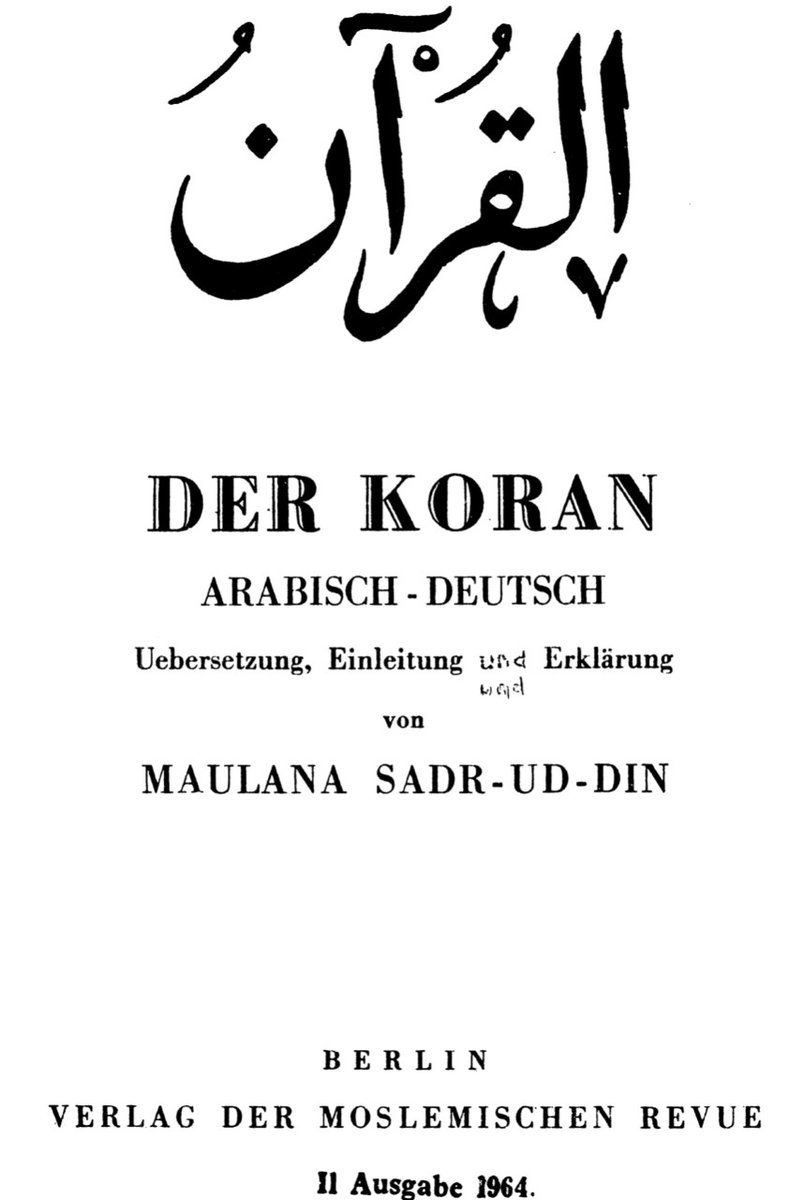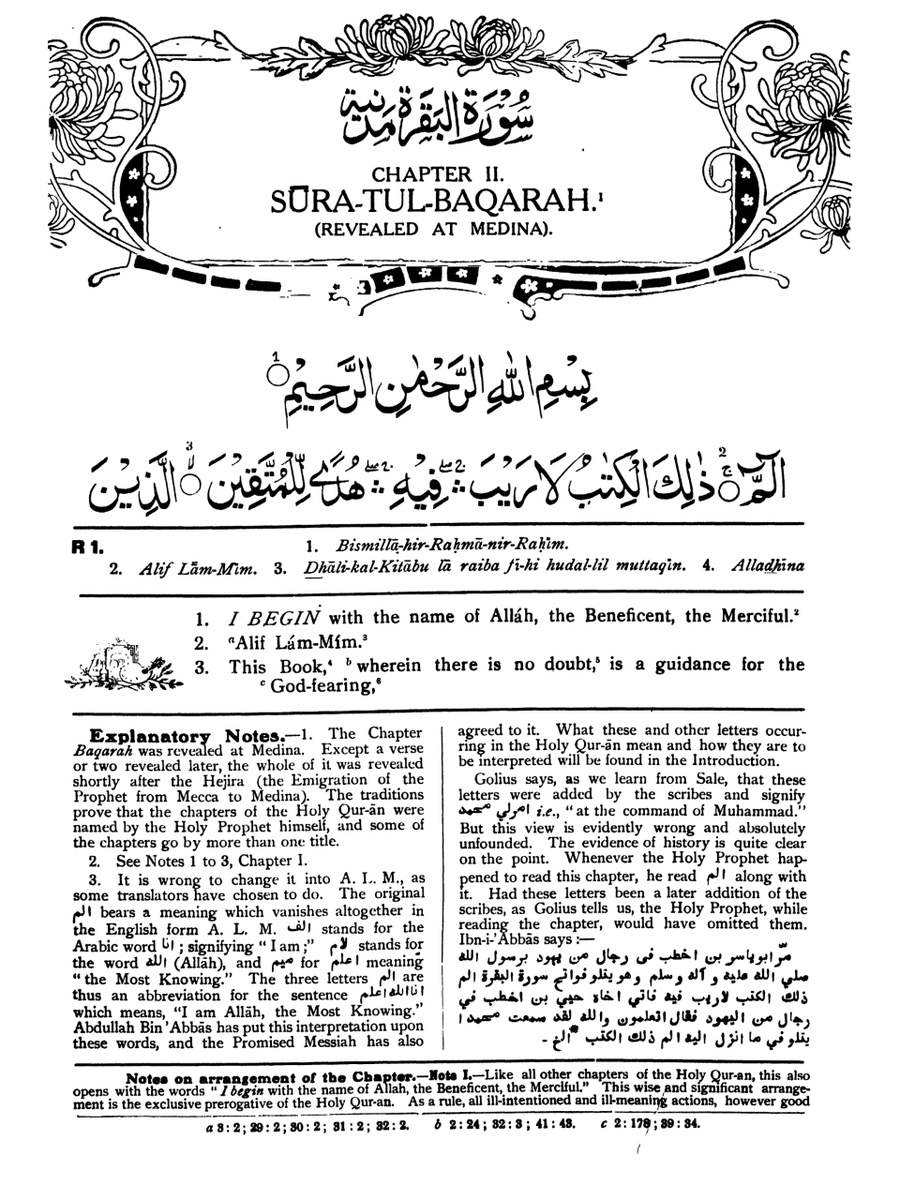
In 1999, al-Azhar University in 🇪🇬 Egypt published the 🇩🇪 German version of its project to standardize Qur’an translation. Has it succeeded in combining the promotion of al-Azhar’s theological doctrine with its claim to being non-divisive? #qurantranslationoftheweek 



Like the versions in other languages (for English and Russian, see gloqur.de/quran-translat… and gloqur.de/quran-translat…), this German Qur’an translation was based on the concise Qur’an commentary 

'Al-Muntakhab’ purports to be a simplified summary of the ‘most correct’ interpretations of the exegetical tradition – a claim that is fraught with problems.
The first edition of the German version carried the title ‘al-Muntakhab: Selections from the Interpretations of the Holy Qur’an: Arabic–German’ (‘al-Muntakhab: Auswahl aus den Interpretationen des Heiligen Koran: Arabisch–Deutsch’). 

The German Muslim Ahmed von Denffer described the format as follows: ‘The volume includes a German translation of the Qur’an together with the Arabic text, while all explanatory notes from the original ‘al-Muntakhab’ have been reproduced in Arabic only, without translation. …
… Occasionally what is contained in these notes has been incorporated into the actual translation, however, at times, without properly identifying it. The publication is therefore only of limited value for the German reader.’
The second and third editions (2007 and 2015, respectively) were clearly meant to rectify these problems and be more accessible:
They contained the Arabic text of the Qur’an only, without the accompanying interpretations from ‘al-Muntakhab,’ in addition to the German translation of the Qur’an and a brief introduction to each sura. 



The new title was ‘German translation of the meanings of the Holy Qur’an: Arabic–German’) (‘Sinngemäße deutsche Übersetzung des Heiligen Koran: Arabisch–Deutsch’), which clearly framed the book as a translation, rather than a Qur’an commentary.
Like most products from al-Azhar, their German Qur’an translation simultaneously embodies the authority of Egyptian state institutions and aims to project some kind of universal Islamic authority.
This is linked to al-Azhar’s claim to represent a theology of ‘the middle way’ (wasaṭiyya). The cover names as publishers ‘The Arab Republic of Egypt; al-Azhar; the Ministry of Awqāf; and the Supreme Council of Islamic Affairs’, giving the book an official feel. 

The second and third edition contain a foreword by Muḥammad Sayyid Ṭanṭāwī (1928–2010), Skaykh al-Azhar at the time of writing (2007), and an introduction by Mahmoud Hamdi Zakzouk (1933–2020), Minister of Awqāf.
In a slightly misplaced attempt to reflect changed political realities, Zakzouk’s name was replaced with the current Minister’s name, Mohammad Mokhtar Gomah, on the cover of the third edition in 2015, even though that edition was an exact reprint of the 2007 edition.
Even Zakzouk’s expression of gratitude to former President Hosni Mubarak for supporting al-Azhar’s efforts to spread the ‘correct image’ of Islam in numerous languages and rectify common misconceptions remained.
The translator was Moustafa Maher, a high-ranking professor of German studies at al-Azhar University. The ‘al-Muntakhab’ project was probably meant to demonstrate the achievements not only of al-Azhar’s religious scholarship, but also of its language department.
However, since Maher was no native speaker of German, the linguistic revision was undertaken by Elsa Maher, presumably his wife, and given a final revision by Ali Huber. 

This dynamic is common in Muslim-authored Qur’an translations, and many orientalist translations as well.
It demonstrates at least two sets of priorities: first, the prioritization of knowledge of Arabic over competence in the target language; and second, the foregrounding of men’s work, with women cast in a supporting role.
The foreword and introduction, too, emphasize the idea that ‘correct’ interpretation and religious scholarship are skills a translator must possess, whereas mastery of the target language is not mentioned.
Accordingly, the translator and the editors clearly had no interest in making the target text emotionally impactful or aesthetically pleasing; the focus was on the unambiguous, ‘correct’ meaning of the Qur’an, a notion that is also repeatedly underlined in the front matter.
Ṭanṭāwī, in his foreword, expounds the preeminence of the Qur’an, the value of tafsīr and the merits (and permissibility) of translation, basing his statements on quotes of scholars from the Azharī tradition.
The ultimate aim of producing Qur’an translations, he argues, is spreading Islam among non-Arabs and motivating them to learn Arabic so they can directly engage with the Arabic Qur’an.
Zakzouk’s introduction goes more deeply into what he presents as the basic theological message of the Qur’an. His description of that message shows slightly modernist leanings: he emphasizes free will, rationalism and the primary function of the Qur’an as a book of guidance.
That last point leads him to present ‘al-Muntakhab’ as a simplified interpretation that avoids complicated linguistic nuances and dogmatic conflicts.
The problem with this is that there are dogmatic conflicts over the correct interpretation of the Qur’an in which al-Azhar is clearly partisan in a way that makes it impossible for them to find a neutral or ‘middle ground’ translation.
This becomes glaringly obvious when one looks at Maher’s translations of verses that involve the anthropomorphic attributes of God.
The interpretation of these verses is the subject of heated controversies in which the Azhar clearly positions itself on the side of the Ashʿarī theological tradition.
Accordingly, all interpretations which might imply that God has human or non-transcendental attributes such as a face, a throne or a position in space are to be avoided.
This can be seen in Maher’s approach to the following segment from Q 2:255: waṣiya kursiyyuhū l-samawāta wa l-arḍ), often understood to mean in a literal sense ‘His Seat (kursī) encompasses the heavens and the earth.’
Maher, however, renders it as ‘His Kursi (his omnipotence) encompasses heaven and earth’ (‘Sein Kursi [seine Allmacht] umfaßt Himmel und Erde’).
This decision not only privileges a purely metaphorical translation, but also omits the rival metaphorical interpretation of ‘kursī’ as ‘omniscience’ in favor of disambiguation.
Maher’s choice to retain the Arabic term ‘kursī’ in the translation, which enables him to avoid any mention of a ‘seat,’ is particularly noteworthy because he usually favors German over Arabic terms, including in his translation of ‘allāh’ as ‘God’ (‘Gott’).
Similarly, Maher’s translation of Q 20:5 (al-raḥmān ʿalā l-ʿarsh istawā, often rendered along the lines of ‘the Merciful, who is established on the Throne’) is so concerned with avoiding anthropomorphism that it bears little relation to the original Arabic wording.
He translates the segment as ‘by the Merciful, the Lord of highest Omnipotence’ (‘von dem Barmherzigen, dem Herrn der höchsten Allmacht’).
The aim of expounding a doctrinally correct interpretation and removing ambiguity, which is apparent in the examples given above, is complemented by the attempt to defuse controversial passages in the Qur’an.
E.g., unlike previous German translators, Maher renders the famous imperative ‘fa-ḍribūhunna’ in Q 4:34, sometimes called the ‘wife-beating verse,’ not as ‘and hit/beat them’ but as ‘punish them (lightly, without humiliating them)’ (‘[leicht] strafen [ohne sie zu erniedrigen]’).
Compared to the translation by the Egyptian Mohammad Rassoul, which was already on the German market in 1999, the language of Maher’s translation, while rather technical, is less archaic and clearer.
The quality of the revision and typesetting is mediocre though, with numerous small mistakes relating to punctuation and capitalization and a failure to use German typographic quotation marks.
The main reason the book did not meet with much success in Germany, however, probably lies elsewhere. It is voluminous, expensive and difficult to obtain.
In contrast to Rassoul, who founded his own publishing house in Germany and whose translation is widely available, al-Azhar has no distribution networks in Germany.
Other competitors on the German Muslim market include the revised editions of Max Henning’s Qur’an translation produced by Turkish publishers, who were far better able than al-Azhar to reach the large number of Turkish mosques in Germany, …
… as well as, from the early 2000s onwards, the translation by Frank Bubenheim and Nadeem Elyas, published by the King Fahd Qur’an Printing Complex, which was often given away for free.
All of these translations found a wider readership than Maher’s. This raises, once again, the question of to what extent the average Muslim reader responds to or is even aware of the claims to authority put forward by al-Azhar and other Muslim institutions.
One also has to wonder how many potential readers expect a ‘correct’ doctrinal position on anthropomorphism in the translation they use, as opposed to simply choosing the most convenient and easily available Qur’an translation. ~ JP ~ #qurantranslationoftheweek
• • •
Missing some Tweet in this thread? You can try to
force a refresh















